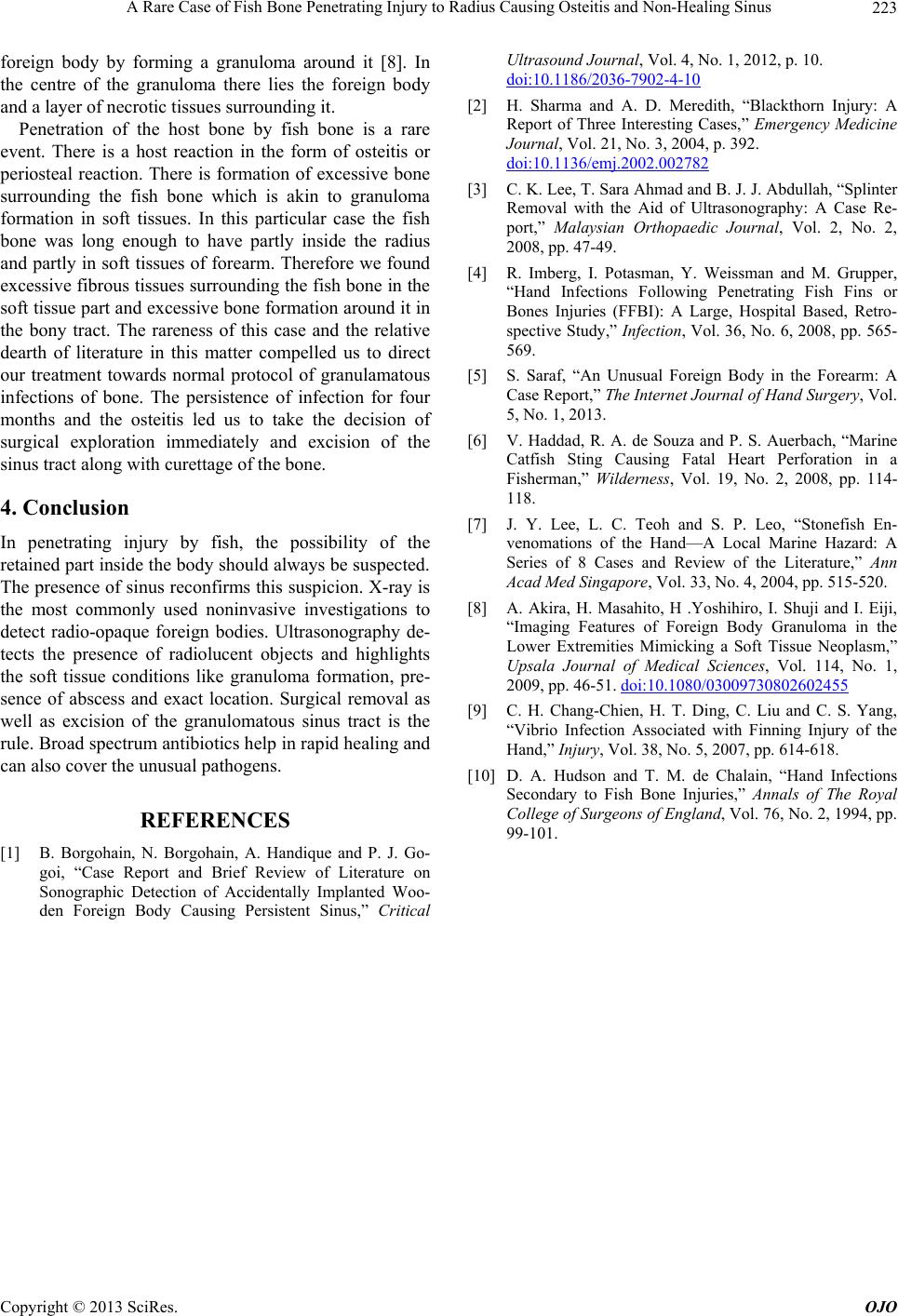
A Rare Case of Fish Bone Penetrating Injury to Radius Causing O s te i t i s a nd Non-Healing Sinus
Copyright © 2013 SciRes. OJO
223
foreign body by forming a granuloma around it [8]. In
the centre of the granuloma there lies the foreign body
and a layer of necrotic tissues surrounding it.
Penetration of the host bone by fish bone is a rare
event. There is a host reaction in the form of osteitis or
periosteal reaction. There is formation of excessive bone
surrounding the fish bone which is akin to granuloma
formation in soft tissues. In this particular case the fish
bone was long enough to have partly inside the radius
and partly in soft tissues of fo rearm. Th erefore w e found
excessive fibrous tissu es surrounding the fish bone in th e
soft tissue part and excessive bone formation around it in
the bony tract. The rareness of this case and the relative
dearth of literature in this matter compelled us to direct
our treatment towards normal protocol of granulamatous
infections of bone. The persistence of infection for four
months and the osteitis led us to take the decision of
surgical exploration immediately and excision of the
sinus tract along with curettage of the bon e.
4. Conclusion
In penetrating injury by fish, the possibility of the
retained part inside the body should always be su spected.
The presence of sinus reconfirms this suspicion. X-ray is
the most commonly used noninvasive investigations to
detect radio-opaque foreign bodies. Ultrasonography de-
tects the presence of radiolucent objects and highlights
the soft tissue conditions like granuloma formation, pre-
sence of abscess and exact location. Surgical removal as
well as excision of the granulomatous sinus tract is the
rule. Broad spectrum antibiotics help in rapid healing and
can also cover the unusual pathogens.
REFERENCES
[1] B. Borgohain, N. Borgohain, A. Handique and P. J. Go-
goi, “Case Report and Brief Review of Literature on
Sonographic Detection of Accidentally Implanted Woo-
den Foreign Body Causing Persistent Sinus,” Critical
Ultrasound Journal, Vol. 4, No. 1, 2012, p. 10.
doi:10.1186/2036-7902-4-10
[2] H. Sharma and A. D. Meredith, “Blackthorn Injury: A
Report of Three Interesting Cases,” Emergency Medicine
Journal, Vol. 21, No. 3, 2004, p. 392.
doi:10.1136/emj.2002.002782
[3] C. K. Lee, T. Sara Ahmad and B. J. J. Abdullah, “Splinter
Removal with the Aid of Ultrasonography: A Case Re-
port,” Malaysian Orthopaedic Journal, Vol. 2, No. 2,
2008, pp. 47-49.
[4] R. Imberg, I. Potasman, Y. Weissman and M. Grupper,
“Hand Infections Following Penetrating Fish Fins or
Bones Injuries (FFBI): A Large, Hospital Based, Retro-
spective Study,” Infection, Vol. 36, No. 6, 2008, pp. 565-
569.
[5] S. Saraf, “An Unusual Foreign Body in the Forearm: A
Case Report,” The Internet Journal of Hand Surgery, Vol.
5, No. 1, 2013.
[6] V. Haddad, R. A. de Souza and P. S. Auerbach, “Marine
Catfish Sting Causing Fatal Heart Perforation in a
Fisherman,” Wilderness, Vol. 19, No. 2, 2008, pp. 114-
118.
[7] J. Y. Lee, L. C. Teoh and S. P. Leo, “Stonefish En-
venomations of the Hand—A Local Marine Hazard: A
Series of 8 Cases and Review of the Literature,” Ann
Acad Med Singapore, Vol. 33, No. 4, 2004, pp. 515-520.
[8] A. Akira, H. Masahito, H .Yoshihiro, I. Shuji and I. Eiji,
“Imaging Features of Foreign Body Granuloma in the
Lower Extremities Mimicking a Soft Tissue Neoplasm,”
Upsala Journal of Medical Sciences, Vol. 114, No. 1,
2009, pp. 46-51. doi:10.1080/03009730802602455
[9] C. H. Chang-Chien, H. T. Ding, C. Liu and C. S. Yang,
“Vibrio Infection Associated with Finning Injury of the
Hand,” Injury, Vol. 38, No. 5, 2007, pp. 614-618.
[10] D. A. Hudson and T. M. de Chalain, “Hand Infections
Secondary to Fish Bone Injuries,” Annals of The Royal
College of Surgeons of England, Vol. 76, No. 2, 1994, pp.
99-101.